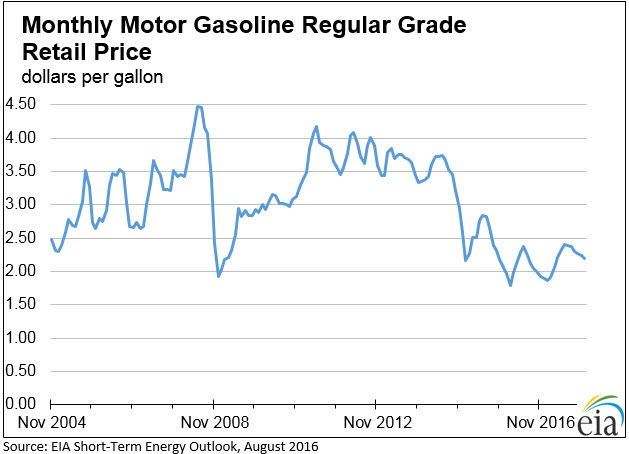Published in the August 2016 issue of
Fleet Affiliation
During this age of low prices for conventional fuel, has your green fleet program become more of a challenge to justify? With the roller coaster of conventional fuel prices over the past decade, are you on track with your green fleet program?
In the short term, we have been enjoying these record low fuel costs that have helped the bottom line with fuel budgets. Unfortunately, upper management within some organizations lack either the understanding or the vision to recognize we are in a temporary reprieve of fuel costs.
Organizations that had alternative fuel fleets in late 2007 and early 2008 were often reconized as forward thinking fleets who were being fiscally responsible when gasoline and diesel prices skyrocketed.
Looking at historical fuel costs, we can hypothesize conventional fuel costs will rise. Proceed cautiously and evaluate all your options with the notion that conventional fuel prices are in a constant state of volatility – even when we are in a historically low period.

Defining “Green”
With new research, regulations and technology, being green or sustainable has taken on a lot of new forms. Beyond the traditional compressed natural gas, propane autogas, electric and hybrid technologies, being sustainable at its most basic form is doing the same amount or more work while using less resources. While using alternative fuels are one great way of accomplishing this, some fleets just don’t have the financial resources available.
GHG – the buzzword
“Greenhouse gas (GHG) emissions” appears to be today’s buzzword – and rightfully so. With Washington considering cutting GHG emissions 80 percent by 2050, some significant changes will come to the field of transportation. This goal won’t happen overnight, but you can understand the importance and take steps now to ensure you won’t be behind the eight ball when strict regulations are put in place.
What can you do now?
Right now, look at your operations and things that may require little to no financial resources. This could be as simple as a truck design. Last month, this column discussed analyzing your operations, right-sizing your fleet, and looking at new technologies. At the basic level, right-sizing vehicles and properly upfitting them to their applications can increase utilization and productivity, thus becoming a more sustainable option because you are now able to do more work with less resources.
Look to the near future
Future environmental regulations such as GHG regulations will have a profound effect on the vocational truck world, as internal combustion engines will have to advance beyond what we have today. Some strategies in use today include:
- Vehicle weight reduction
- Improved aerodynamics
- Low rolling resistance tires
- Engine cylinder deactivation
- Smaller engine displacement – advanced turbo chargers
- Automatic engine start/stop technology
As technology advances, the modern truck as we know it will as well. There will be no single solution or silver bullet, but a combination of technological improvements, vehicle selection and utilization.
If you would like to discuss this, or any other fleet issue, contact NTEA Fleet Relations Director Chris Lyon at
chris@ntea.com.